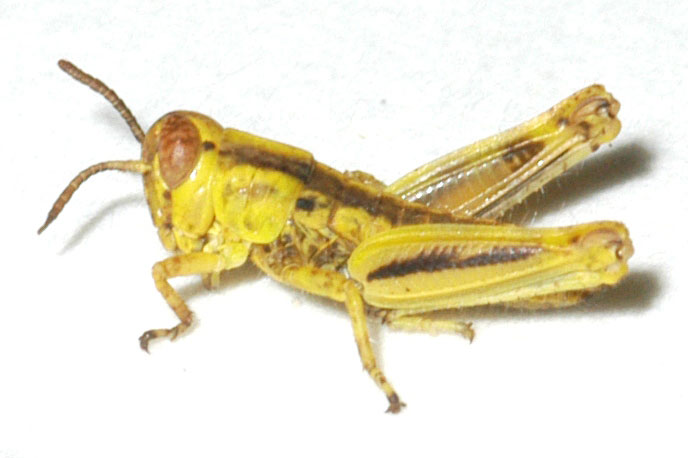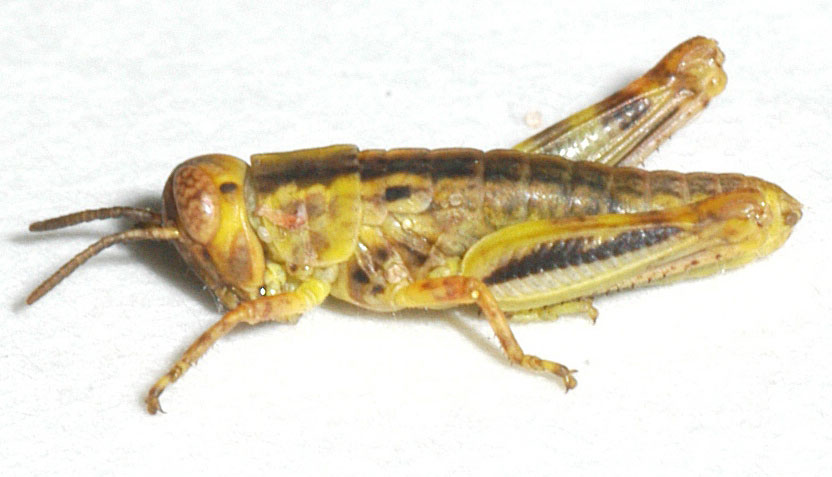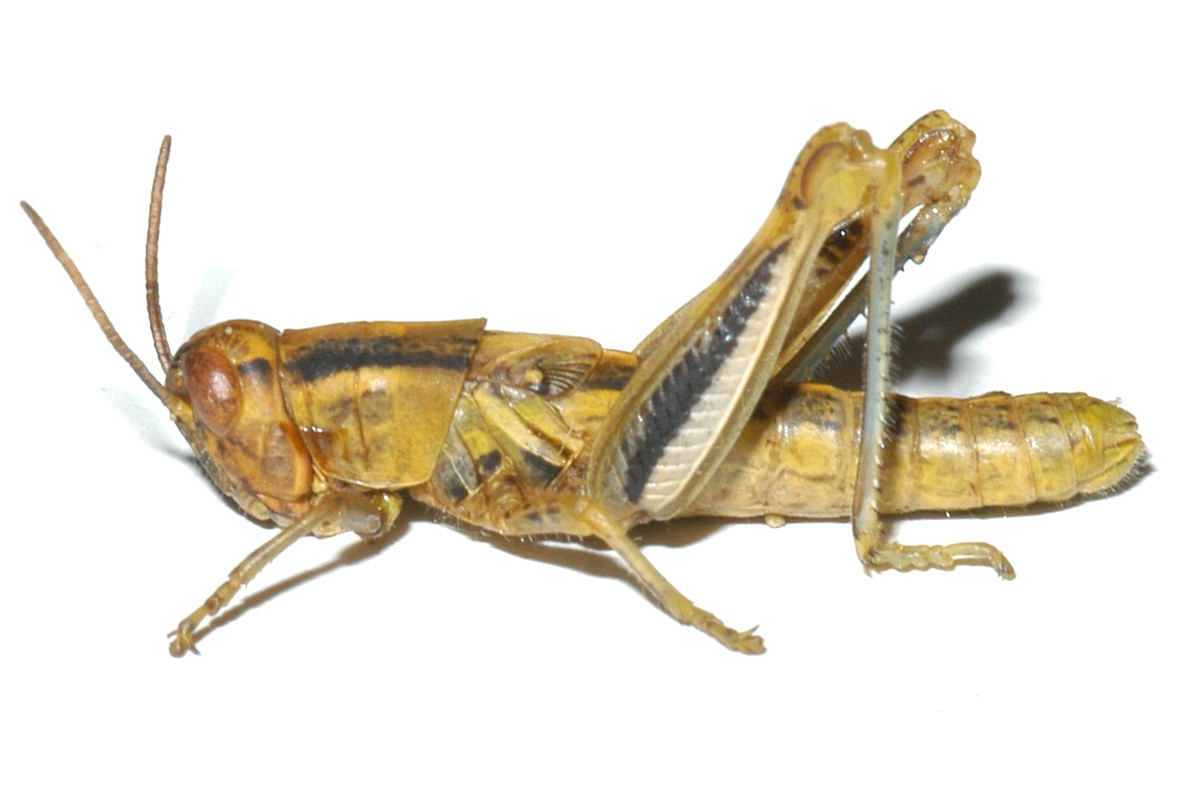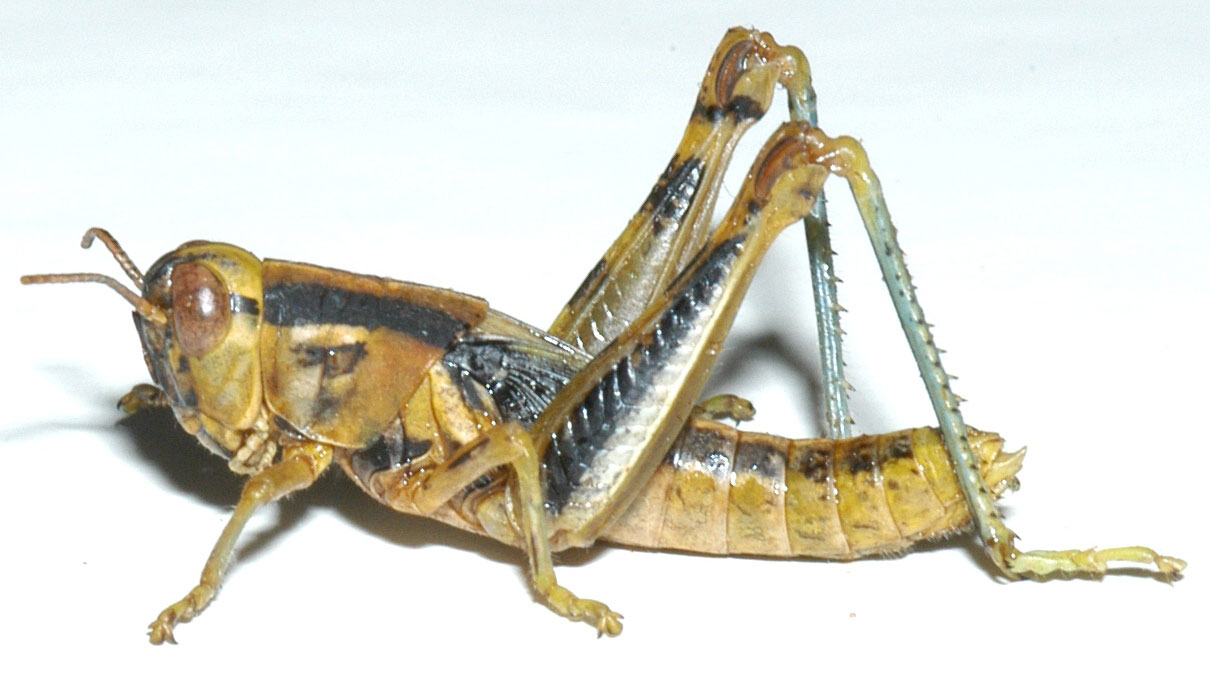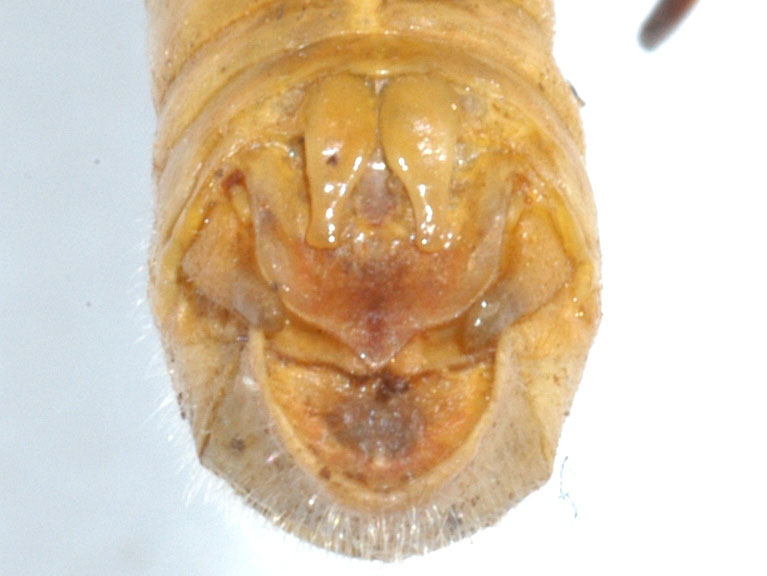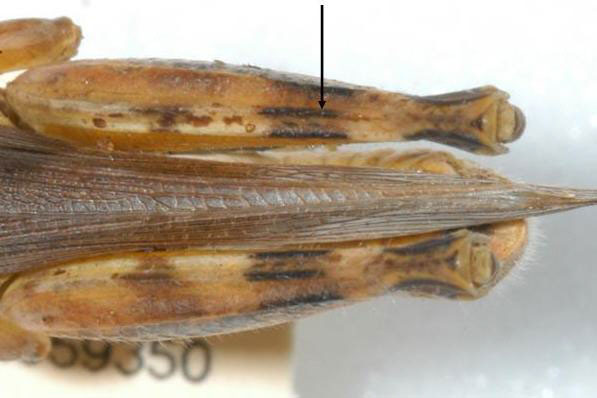Melanoplus flavidus
|
Geographic range of Melanoplus flavidus (Scudder) |
|
Fig. 1, first instar: BL 5-9 mm, FL 3-5 mm, AS 12-16 |
|
Fig. 2, second instar: BL 9-13 mm, FL 5.5-7.5 mm, AS 16-20 |
|
Fig. 3, third instar: BL 11.5-17.5 mm, FL 6.5-9 mm, AS 19-22 |
|
Fig. 4, fourth instar: BL 14-22 mm, FL 8.5-12 mm, AS 22-25 |
|
Fig. 5, fifth instar: BL 21-27 mm, FL 11.5-14.5 mm, AS 24-27 |
|
Fig. 6, adult male: BL 22-28 mm, FL 12-17 mm, AS 25-28 |
|
Fig. 7, adult female: BL 24-31 mm, FL 13-18 mm, AS 25-28 |
|
Fig. 8, lateral view of male cerci and furcula |
|
Fig. 9, dorsal view of male cerci and furcula |
|
Fig. 10, dorsal view of hind femur |
Species
Yellowish spurthroat grasshopper
Melanoplus flavidus (Scudder)
Subfamily Melanoplinae
Identification
The adults of both sexes are very similar in general appearance. It is overall yellowish in color, with yellowish brown tegmina. Postocular bars are usually poorly developed but may occasionally consist of a somewhat broad black band. The postocular bars of Melanoplus bowditchi tend to be much more developed, but this is not always a dependable character. The hind femur is whitish over the lower third, with diffuse blue covering much of the middle and fading to yellowish along the dorsal third or also covering the dorsal third, and becoming largely contiuous with two distinct brownish to blackish bars in the dorsal region of the outer surface. The continuous dark areas extending from the upper half of the outer surface to the dorsal surface is a fairly reliable character to differentiate M. flavidus form M. bowditchi. The hind femur is distinctly orange-yellow along the ventral edge. The dorsal ridges of the hind femur have at least some blackish on the edge of the ridge (at least one), while in M. bowditchi the edges of the ridges are always pale to moderately brown. The inner surface of the hind femur is unmarked greenish yellow, yellow, or orange-yellow. While the inner hind femur is normally more yellowish in color than in M. bowditchi (in which is distinctly orange), even this character overlaps in a few specimens of each species. The hind tibiae are blue with spines blackish at the tips. The cerci of the male are virtually indistinguishable from those of M. bowditchi. It is normally best differentiated from M. bowditchi by comparing aedeagal features of the male, but characters of the hind femur are consistently different in Nebraska populations. The end of the aedeagus in M. bowditchi is rounded, but has a distinct cup-like depression in M. flavidus. In addition, the shape of the furculae is a consistent tool to differentiate these two species. In M. bowditchi the ends of the furculae are distinctly incurved, rounded, and not expanded. In M. flavidus the ends are sometimes recurved as well, but are bluntly squared off and slightly widened near the tip.
The nymphs (Figs. 1-5) are identifiable by their shape, stripes, and color:
- Head with face nearly vertical; face colored greenish yellow with dark stripe behind eye; antennae filiform; compound eye with no distinct markings.
- Cream-colored crescent begins on side of head below and to the rear of the compound eye and runs onto lobe of pronotum; however, side of head may be solid greenish yellow without crescent in early instars and a cream-colored line may also be lacking on pronotal lobe.
- Medial area of hind femur variable - with fuscous stripe entire, small notch in dorsal part of fuscous stripe 2/3 to distal end diagnostic in all instars.
- Body color is greenish yellow; underside greenish yellow.
Distribution and habitat
The yellowish spurthroat grasshopper ranges from Alberta and Manitoba to Arizona, Texas, Illinois, and Wisconsin. It occurs in sandy habitats with sparse vegetation, particularly where the sand is somewhat poorly stabilized. In the sandhills of Nebraska, it is particularly common in the vicinity of blowouts and in sparsely vegetated or overgrazed sandy rangeland.
Economic importance
While Melanoplus flavidus may occur at moderate densities, it prefers weedy forbs in areas with sparse vegetation, and it is thus unlikely to cause economic damage. It can, however, become a pest of cultivated crops.
Food preferences
Melanoplus flavidus is mostly a forb feeder, but does ingest some grasses. Crop analysis in North Dakota revealed feeding on three grass species, one sedge, and ten forbs. These plants included Kentucky bluegrass, western ragweed, leadplant, cudweed sagewort, prairie sunflower, narrowleaf gromwell, and Missouri goldenrod. It is particularly fond of sunflower, and it has been observed feeding on the flowers. In North Dakota, the mandibles are distinctly of the forbivorous type. In Nebraska, it has been observed feeding on the leaves of sunflower.
Dispersal and migration
The dispersal ability of this grasshopper is not well known, but it does possess especially long wings and is expected to be capable of sustained flight.
Hatching
Eggs reportedly hatch in early June.
Nymphal development
Nymphs develop through five instars. Adulthood is reached primarily in middle and late July.
Adults and reproduction
Adults appear in late July and remain until mid-September in Colorado. In Nebraska, they are most common from about July 25 to September 10. Egg pods contain approximately 14 yellowish eggs, which are arranged in two or three disorderly columns. Eggs are 5 mm in length and 1.2 mm in width. The reproductive behavior of the blue-legged grasshopper has not been studied in detail.
Population ecology
The population ecology of this grasshopper is not well-known, but it is generally always common in areas with an abundance of loose sand.
Daily activity
The daily activity of the blue-legged grasshopper has not been studied, but it has been noted as high as a meter above ground on sunflower leaves during hot afternoons in the sandhills of Nebraska.
Source and date
University of Nebraska by Mathew Brust March 2007
Selected references
Blatchley, W. S. 1920. Orthoptera of Northeastern America, with especial reference to the faunas of Indiana and Florida. The Nature Publishing Company, Indianapolis, Indiana. 784 pp.
Capinera, J. L. and T. S. Sechrist. 1982. Grasshoppers (Acrididae) of Colorado: Identification, biology and management. Colorado State University Experiment Station Bulletin No. 5848. 161 pp.
Gillette, C. P. 1904. Annotated list of Colorado Orthoptera. Colorado Agriculture Experiment Station Bulletin 94: 17-67.
Hart, C. A. and H. A. Gleason. 1907. On the biology of the sand areas of Illinois. Bulletin of the Illinois State Laboratory of Natural History 7: 137-272.
Helfer, J. R. 1987. How to Know the Grasshoppers, Crickets, Cockroaches and Their Allies. Dover Publications Inc. New York, New York. 363 pp.
Onsager, J. A., and C. B. Mulkern. 1963. Identification of eggs and egg pods of North Dakota grasshoppers (Orthoptera: Acrididae). North Dakota Agriculture Experiment Station Bulletin 446: 1-48.


